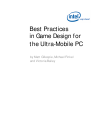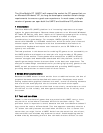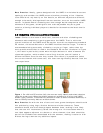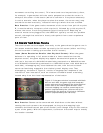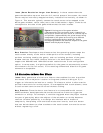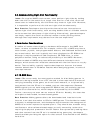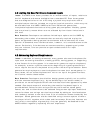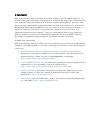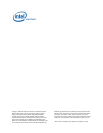3.4 Accommodating Right-Click Functionality
Issue: On a typical UMPC touch-screen, users perform right-clicks by holding
down the click on the screen for a longer time than for a left-click, which can
cause users to inadvertently left-click when they mean to right-click. Moreover,
it is impossible to perform a left-click and right-click simultaneously.
Best Practice: Developers should provide alternative user interactions to
replace right-click functionality, such as using double-clicks or clickable controls
on the screen that take place of right-clicking. Alternatively, game developers
can simply require the use of an external mouse or other pointing device,
although that requirement may detract from the user experience.
4 Form Factor Considerations
A number of issues relate directly to hardware differences in the UMPC form
factor, relative to standard PCs. For example, unlike a PC, a UMPC may have a
touch screen, joystick, user-programmable buttons, and dedicated buttons such
as a menu button, but it will typically not have a keyboard or CD-ROM drive.
Although it may be possible to add a keyboard, CD-ROM drive, or other
peripheral devices, doing so reduces the portability of the UMPC. Moreover,
different models of UMPCs may have different elements included in their
designs, which causes the limitations associated with the form factor to vary by
device. That variability typically requires developers to focus on the lowest
common denominator of hardware features when designing games, in terms of
core requirements.
4.1 CD-ROM Drive
Issue: CDs are currently the most popular method for distributing games. In
addition to being installed from a CD, the disk is often required as a means of
verifying ownership of the game, as an anti-theft measure, or to dynamically
load content from the CD as it is needed, such as video sequence. Because
UMPCs typically do not have integrated CD-ROM drives, this modality requires
the use of an external drive, which hampers the portability of the UMPC.
Further, users may not even own an external CD drive. Notably, this issue has
no impact on web-hosted, browser-based games.
Best Practice: Making games able to be downloaded and installed via the
Internet is an ideal alternative to CDs for UMPC games. This distribution model
is already in widespread use, and developers should consider the emergence of
UMPCs as a further impetus to expand upon it. They should also consider using
certificates or other software-based means to verify ownership, rather than
requiring the physical presence of the CD. Rather than dynamically loading video
and other content from the CD as it is needed during game play, developers
should consider providing the option for that content to be hosted on the UMPC's
hard drive.



